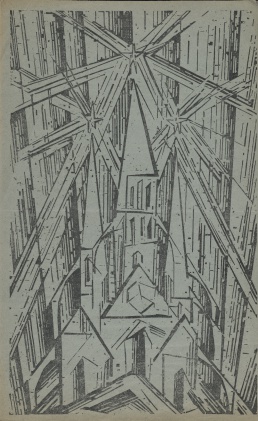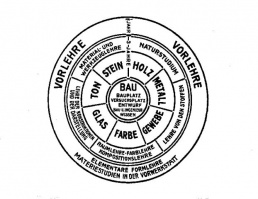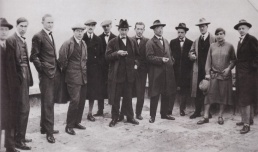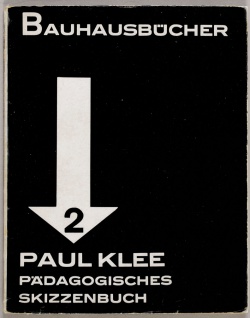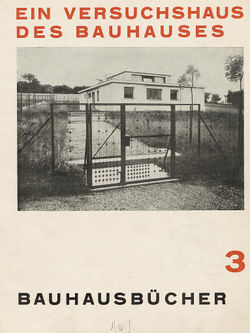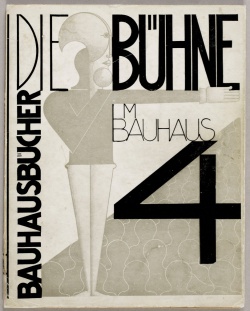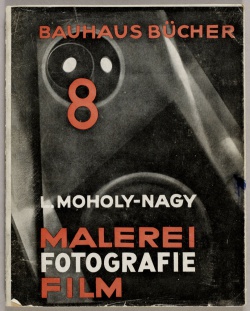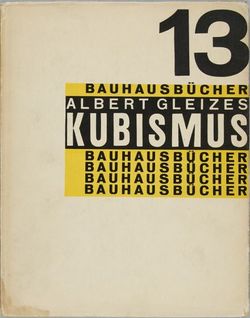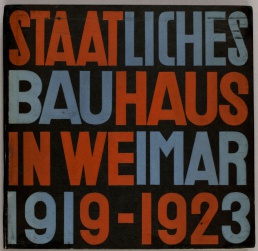Difference between revisions of "Bauhaus"
(→Books) |
|||
| (6 intermediate revisions by the same user not shown) | |||
| Line 59: | Line 59: | ||
[[Image:Gleizes_Albert_Kubismus_1928.jpg|thumb|250px|'''13.''' Albert Gleizes, ''Kubismus'', 1928. 101 p.]] | [[Image:Gleizes_Albert_Kubismus_1928.jpg|thumb|250px|'''13.''' Albert Gleizes, ''Kubismus'', 1928. 101 p.]] | ||
| | | | ||
| − | [[Image:Moholy-Nagy_Laszlo_Von_Material_zu_Architektur_1929.jpg|thumb|250px|'''14.''' László Moholy-Nagy, ''Von Material | + | [[Image:Moholy-Nagy_Laszlo_Von_Material_zu_Architektur_1929.jpg|thumb|250px|'''14.''' László Moholy-Nagy, ''Von Material zu Architektur'', 1929. 241 p. [http://monoskop.org/log/?p=8788 Log], [[Media:Moholy-Nagy_Laszlo_Von_Material_zu_Architektur_1929.pdf|PDF]] (98 MB).]] |
|} | |} | ||
| Line 92: | Line 92: | ||
* '''11.''' Kasimir Malewitsch, ''[http://bibliothequekandinsky.centrepompidou.fr/imagesbk/RLPF731/M5050_X0031_LIV_RLPF0731.pdf Die gegenstandslose Welt]'', Munich: Albert Langen, 1927, 104 pp, [https://doi.org/10.11588/diglit.43957 PDF, JPG]; new ed., exp., Mainz: Florian Kupferberg, 1980. Russian original written in 1923. | * '''11.''' Kasimir Malewitsch, ''[http://bibliothequekandinsky.centrepompidou.fr/imagesbk/RLPF731/M5050_X0031_LIV_RLPF0731.pdf Die gegenstandslose Welt]'', Munich: Albert Langen, 1927, 104 pp, [https://doi.org/10.11588/diglit.43957 PDF, JPG]; new ed., exp., Mainz: Florian Kupferberg, 1980. Russian original written in 1923. | ||
| − | ** ''The Non-Objective World'', trans. Howard Dearstyne, Chicago: P. Theobald, 1959, 102 pp. {{en}} | + | ** ''[[Media:Malevich_Kasimir_The_Non-Objective_World_1959.pdf|The Non-Objective World]]'', trans. Howard Dearstyne, Chicago: P. Theobald, 1959, 102 pp. {{en}} |
** [[Malevich#Malevich1927|more translations]] | ** [[Malevich#Malevich1927|more translations]] | ||
| Line 101: | Line 101: | ||
** [[Cubism#Gleizes1928|more translations]] | ** [[Cubism#Gleizes1928|more translations]] | ||
| − | * '''14.''' László Moholy-Nagy, ''[http://monoskop.org/log/?p=8788 Von Material | + | * '''14.''' László Moholy-Nagy, ''[http://monoskop.org/log/?p=8788 Von Material zu Architektur]'', Munich: Albert Langen, 1929, 241 pp; facsimile repr., Mainz and Berlin: Florian Kupferberg, 1968, 251 pp. |
** ''The New Vision: From Material to Architecture'', trans. Daphne M. Hoffman, New York: Breuer Warren and Putnam, 1930; exp.rev.ed. as ''[http://monoskop.org/log/?p=8788 The New Vision and Abstract of an Artist]'', New York: George Wittenborn, 1947, 92 pp. {{en}} | ** ''The New Vision: From Material to Architecture'', trans. Daphne M. Hoffman, New York: Breuer Warren and Putnam, 1930; exp.rev.ed. as ''[http://monoskop.org/log/?p=8788 The New Vision and Abstract of an Artist]'', New York: George Wittenborn, 1947, 92 pp. {{en}} | ||
** [[Moholy-Nagy#Moholy1929|more translations]] | ** [[Moholy-Nagy#Moholy1929|more translations]] | ||
| Line 218: | Line 218: | ||
* Robert Wiesenberger, [http://www.harvardartmuseums.org/tour/the-bauhaus/slide/6339 "The Bauhaus and Harvard"], 2016. {{en}} | * Robert Wiesenberger, [http://www.harvardartmuseums.org/tour/the-bauhaus/slide/6339 "The Bauhaus and Harvard"], 2016. {{en}} | ||
* Markéta Svobodová, ''Bauhaus a Československo 1919-1938: studenti, koncepty, kontakty / The Bauhaus and Czechoslovakia 1919-1938: Students, Concepts, Contacts'', Prague: Kant, 2016, 255 pp. [http://www.kant-books.cz/cs/publikace/bauhaus-a-ceskoslovensko-1819-1938/] {{cz}}/{{en}} | * Markéta Svobodová, ''Bauhaus a Československo 1919-1938: studenti, koncepty, kontakty / The Bauhaus and Czechoslovakia 1919-1938: Students, Concepts, Contacts'', Prague: Kant, 2016, 255 pp. [http://www.kant-books.cz/cs/publikace/bauhaus-a-ceskoslovensko-1819-1938/] {{cz}}/{{en}} | ||
| − | * Elizabeth Otto, Patrick Rössler (eds.), ''[http://library.memoryoftheworld.org/ | + | * Elizabeth Otto, Patrick Rössler (eds.), ''[http://library.memoryoftheworld.org/#/book/7c0bca14-7fea-4c1a-b776-9f2a77b60d9f Bauhaus Bodies: Gender, Sexuality, and Body Culture in Modernism’s Legendary Art School]'', Bloomsbury, 2019, 392 pp. [https://www.bloomsbury.com/uk/bauhaus-bodies-9781501344787/] {{en}} |
* Elizabeth Otto, Patrick Rössler, ''Bauhaus Women: A Global Perspective'', London: Palazzo, 2019, 192 pp. [https://www.palazzoeditions.com/global-bauhaus-women] {{en}} | * Elizabeth Otto, Patrick Rössler, ''Bauhaus Women: A Global Perspective'', London: Palazzo, 2019, 192 pp. [https://www.palazzoeditions.com/global-bauhaus-women] {{en}} | ||
** ''Frauen am Bauhaus. Die Wegweisende Künstlerinnen der Modern'', trans. Birgit van der Avoort, Munich: Knesebeck, 2019, 192 pp. [https://www.knesebeck-verlag.de/frauen_am_bauhaus/t-1/735] {{de}} | ** ''Frauen am Bauhaus. Die Wegweisende Künstlerinnen der Modern'', trans. Birgit van der Avoort, Munich: Knesebeck, 2019, 192 pp. [https://www.knesebeck-verlag.de/frauen_am_bauhaus/t-1/735] {{de}} | ||
| − | * Elizabeth Otto, ''Haunted Bauhaus: | + | * Patrick Rössler, ''Bauhausmädels: A Tribute to Pioneering Women Artists'', Taschen, 2019, 480 pp. [https://www.taschen.com/pages/en/catalogue/photography/all/05320/facts.bauhausmaedels_a_tribute_to_pioneering_women_artists.htm] {{en}}/{{fr}}/{{de}} |
| + | * Elizabeth Otto, ''Haunted Bauhaus: Occult Spirituality, Gender Fluidity, Queer Identities, and Radical Politics'', MIT Press, 2019, 296 pp. [https://mitpress.mit.edu/books/haunted-bauhaus] {{en}} | ||
===Sound recordings=== | ===Sound recordings=== | ||
| Line 251: | Line 252: | ||
* [https://www.bauhaus100.de/ Bauhaus100: 100 Jahre Bauhaus]. A collaboration between Bauhaus-Archiv / Museum für Gestaltung in Berlin, Stiftung Bauhaus Dessau, and Klassik Stiftung Weimar, 2019. | * [https://www.bauhaus100.de/ Bauhaus100: 100 Jahre Bauhaus]. A collaboration between Bauhaus-Archiv / Museum für Gestaltung in Berlin, Stiftung Bauhaus Dessau, and Klassik Stiftung Weimar, 2019. | ||
* [http://www.fembio.org/biographie.php/frau/specials/Bauhausfrauen/ Bauhausfrauen], biographies of Bauhaus women on FemBio. | * [http://www.fembio.org/biographie.php/frau/specials/Bauhausfrauen/ Bauhausfrauen], biographies of Bauhaus women on FemBio. | ||
| + | * [https://www.making-futures.com/ Making Futures Bauhaus+], an action research project that addresses questions of architecture as a collective form and architecture as a resource. Initiated in 2018 by raumlabor and the Berlin University of the Arts. | ||
* [http://www.baunet-info.com/ Baunet: Bauhaus Networking Ideas and Practice], an international research and exhibition project, coordinated by the Museum of Contemporary Art Zagreb, started 2013. | * [http://www.baunet-info.com/ Baunet: Bauhaus Networking Ideas and Practice], an international research and exhibition project, coordinated by the Museum of Contemporary Art Zagreb, started 2013. | ||
* [http://www.modell-bauhaus.de/ Modell Bauhaus], an exhibition at Bauhaus-Archiv/Martin-Gropius-Bau, Berlin, 2009. | * [http://www.modell-bauhaus.de/ Modell Bauhaus], an exhibition at Bauhaus-Archiv/Martin-Gropius-Bau, Berlin, 2009. | ||
Revision as of 21:00, 10 December 2019
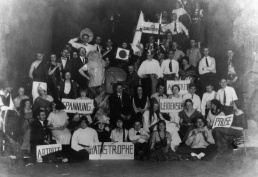
The Bauhaus was founded in 1919 in the city of Weimar by German architect Walter Gropius. Its core objective was a radical concept: to reimagine the material world to reflect the unity of all the arts. Gropius explained this vision for a union of crafts, art and technology in the Programm des Staatlichen Bauhauses Weimar (1919), which described a utopian craft guild combining architecture, sculpture, and painting into a single creative expression [Gesamtkunstwerk]. Gropius developed a curriculum that would turn out artisans and designers capable of creating useful and beautiful objects appropriate to this new system of living.
The Bauhaus combined elements of both fine arts and design education. The curriculum commenced with a preliminary course that immersed the students, who came from a diverse range of social and educational backgrounds, in the study of materials, colour theory, and formal relationships in preparation for more specialized studies. This preliminary course was often taught by visual artists, including Johannes Itten, László Moholy-Nagy, Josef Albers, Paul Klee, and Wassily Kandinsky, among others.
The workshops included metalworking, weaving, ceramics, carpentry, graphic printing, printing and advertising, photography, glass and wall painting, stone and wood sculpture, and theatre. Among the teachers were also Herbert Bayer, Marcel Breuer, Hinnerk Scheper, Joost Schmidt, Gunta Stölzl, and Walter Peterhans. (More about the workshops, classes, and teachers and students.)
In 1925, the Bauhaus moved from Weimar to Dessau. Gropius stepped down as director of the Bauhaus in April 1928, succeeded by the architect Hannes Meyer. Under pressure from an increasingly right-wing municipal government, Meyer resigned as director of the Bauhaus in 1930. He was replaced by architect Ludwig Mies van der Rohe. The political situation in Germany, combined with the perilous financial condition of the Bauhaus, caused Mies to relocate the school to Berlin in September 1932, where it operated on a reduced scale. The Bauhaus eventually dissolved itself under pressure from the Nazis in 1933.
During the years of World War II, many of the key figures of the Bauhaus emigrated to the United States, where their work and their teaching philosophies influenced generations of young architects and designers. Marcel Breuer and Josef Albers taught at Yale, Walter Gropius went to Harvard, and Moholy-Nagy established the New Bauhaus in Chicago in 1937. [2] [3]
Books
| The following nine PDFs are linked from the Bibliothèque Kandinsky which published them online on an unknown date (follow this link to explore the respective entries on its website). This is an important milestone in the digitisation of essential but hard-to-get art publications for the public use and we would like to express our gratitude and appreciation. <3 ! The whole set of these high-quality digital facsimiles is about 1 GB large, if anyone feels like starting a torrent to relieve bandwidth of the library let us know and we'll include your link here (17 Aug 2014). Update: you can now download the whole set in a single ZIP file from here. Thanks to Gabriel Benderski (29 Aug 2014). Update: volumes 3, 5, 6, 14 have now been added as well; they are not part of the ZIP file (7 Jul 2019). |
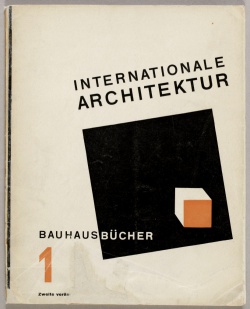 1. Walter Gropius (ed.), Internationale Architektur, 1925. 111 p., 23 cm. PDF (111 MB). |
 7. Neue Arbeiten der Bauhauswerkstätten, 1925. 115 p., 23 cm. PDF (118 MB). |
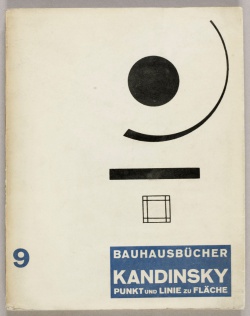 9. Kandinsky, Punkt und Linie zu Fläche: Beitrag zur Analyse der malerischen Elemente, 1926. 190 p., 23 cm. PDF (134 MB). |
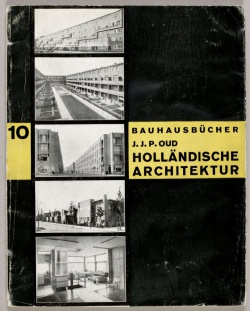 10. J.J.P. Oud, Holländische Architektur, 1926. 107 p., 23 cm. PDF (89 MB). |
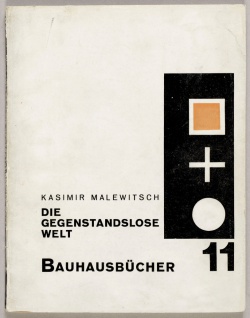 11. Kasimir Malewitsch, Die gegenstandslose Welt, 1927. 104 p., 24 cm. PDF (84 MB). |
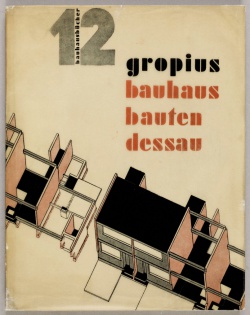 12. Walter Gropius, Bauhausbauten Dessau, 1930. 221 p., 23 cm. PDF (222 MB). |
- 1. Walter Gropius (ed.), Internationale Architektur, Munich: Albert Langen, 1925, 111 pp, PDF, JPG.
- 2. Paul Klee, Pädagogisches Skizzenbuch, Munich: Albert Langen, 1925, 50 pp, PDF, JPG.
- Pedagogical Sketchbook, intro. & trans. Sibyl Moholy-Nagy, New York: Frederick A. Praeger, 1953, 65 pp; 1960. (English)
- more translations
- 3. Adolf Meyer (ed.), Ein Versuchshaus des Bauhauses in Weimar, Munich: Albert Langen, 1925, 78 pp.
- 4. Die Bühne am Bauhaus, Munich: Albert Langen, 1925, 84 pp, PDF, JPG.
- The Theater of the Bauhaus, trans. Arthur S. Wensinger, Middletown, Conn.: Wesleyan University Press, 1961. (English)
- 5. Piet Mondrian, Neue Gestaltung, Neoplastizimus, Nieuwe Beelding, Munich: Albert Langen, 1925, 66 pp.
- 6. Theo van Doesburg, Grundbegriffe der neuen gestaltenden Kunst, Munich: Albert Langen, 1925, 40+[26] pp.
- Principles of Neo-Plastic Art, intro. Hans M. Wingler, afterw. H.L.C. Jaffé, trans. Janet Seligman, London: Lund Humphries, 1968, x+73 pp; Greenwich, CT: New York Graphic Society, 1968, x+73 pp, PDF. (English)
- more translations
- 7. Walter Gropius (ed.), Neue Arbeiten der Bauhauswerkstäffen, Munich: Albert Langen, 1925, 115 pp, PDF, JPG.
- 8. L. Moholy-Nagy, Malerei, Fotografie, Film, Munich: Albert Langen, 1925, 115 pp; 2nd ed., exp., 1927, 140 pp, PDF, JPG. Incl. "Dynamik der Gross-Stadt", pp 116-129.
- Painting Photography Film, trans. Janet Seligman, London: Lund Humphries, 1969. (English)
- more translations
- 9. Kandinsky, Punkt und Linie zu Fläche: Beitrag zur Analyse der malerischen Elemente, Munich: Albert Langen, 1926, 190 pp, PDF, JPG.
- Point and Line to Plane: Contribution to the Analysis of the Pictorial Elements, trans. Howard Dearstyne and Hilla Rebay, New York: Solomon R. Guggenheim Foundation, 1947, 200 pp. (English)
- more translations
- 10. J.J.P. Oud, Holländische Architektur, Munich: Albert Langen, 1926, 107 pp.
- 11. Kasimir Malewitsch, Die gegenstandslose Welt, Munich: Albert Langen, 1927, 104 pp, PDF, JPG; new ed., exp., Mainz: Florian Kupferberg, 1980. Russian original written in 1923.
- The Non-Objective World, trans. Howard Dearstyne, Chicago: P. Theobald, 1959, 102 pp. (English)
- more translations
- 12. Walter Gropius, Bauhausbauten Dessau, Munich: Albert Langen, 1930, 221 pp.
- 13. Albert Gleizes, Kubismus, Munich: Albert Langen, 1928, 101 pp; repr. in Gleizes, Puissances du cubisme, 1969; repr., Mainz and Berlin: Florian Kupferberg, 1980. Written 1925-28.
- The Epic: From Immobile Form to Mobile Form, trans. Peter Brooke, Association des Amis d'Albert Gleizes, 1995. (English)
- more translations
- 14. László Moholy-Nagy, Von Material zu Architektur, Munich: Albert Langen, 1929, 241 pp; facsimile repr., Mainz and Berlin: Florian Kupferberg, 1968, 251 pp.
- The New Vision: From Material to Architecture, trans. Daphne M. Hoffman, New York: Breuer Warren and Putnam, 1930; exp.rev.ed. as The New Vision and Abstract of an Artist, New York: George Wittenborn, 1947, 92 pp. (English)
- more translations
Journal
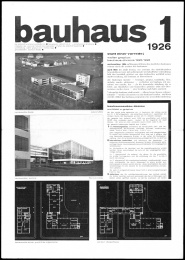 bauhaus 1:1 (4 Dec 1926). PDF (16 mb). |
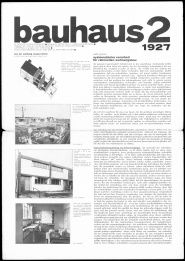 bauhaus 1:2 (24 Apr 1927). PDF (16 mb). |
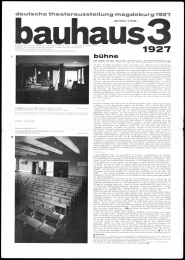 bauhaus 1:3 (10 Jul 1927). PDF (17 mb). |
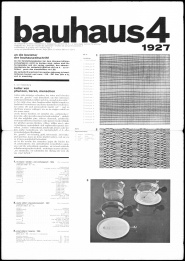 bauhaus 1:4 (24 Oct 1927). PDF (16 mb). |
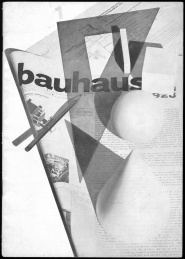 bauhaus: zeitschrift für bau und gestaltung 2:1 (15 Feb 1928). PDF (24 mb). |
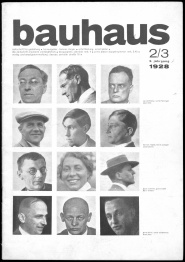 bauhaus: zeitschrift für gestaltung 2:2/3 (1 Jul 1928). PDF (45 mb). |
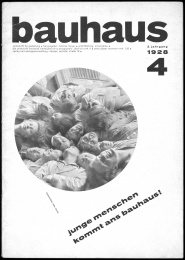 bauhaus: zeitschrift für gestaltung 2:4 (1 Oct 1928). PDF (45 mb). |
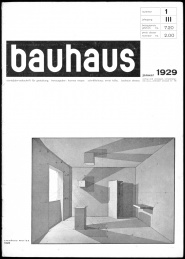 bauhaus: zeitschrift für gestaltung 3:1 (1 Jan 1929). PDF (42 mb). |
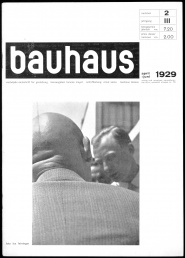 bauhaus: zeitschrift für gestaltung 3:2 (15 May 1929). PDF (42 mb). |
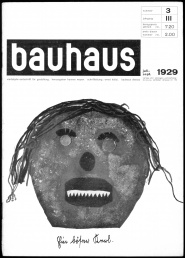 bauhaus: zeitschrift für gestaltung 3:3 (15 Jul 1929). PDF (44 mb). |
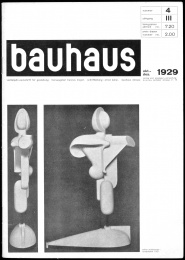 bauhaus: zeitschrift für gestaltung 3:4 (15 Nov 1929). PDF (42 mb). |
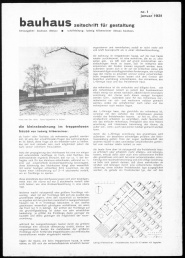 bauhaus: zeitschrift für gestaltung 4:1 (Jan 1931). PDF (5 mb). |
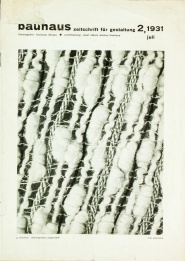 bauhaus: zeitschrift für gestaltung 4:2 (Jul 1931). PDF (15 mb). |
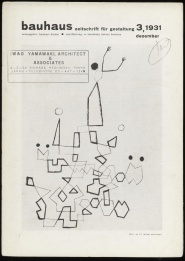 bauhaus: zeitschrift für gestaltung 4:3 (Dec 1931). PDF (8 mb). |
The above PDFs were assembled from scans on IADDB.org, with the exception of 4(2) which is sourced from Baunet Reader.
Beinecke Rare Book and Manuscript Library hosts partial scan of 1(1), and Baunet Reader offers different scans of 2(1) and 3(1-3) as PDFs.
- bauhaus, zeitschrift für gestaltung, eds. Walter Gropius and Laszlo Moholy-Nagy (1:1-2:1), Ernst Kállai (2:2/3-3:4), Ludwig Hilberseimer (4:1), Josef Albers (4:2), W. Kandinsky (4:3), 14 issues, Dessau, 1926-31; repr., Nendeln: Klaus Reprint, 1977.
Other publications
(in German unless noted otherwise)
- Walter Gropius, Programm des Staatlichen Bauhauses Weimar, Weimar, April 1919, 4 pp.
- "Program of the Staatliche Bauhaus in Weimar", in Hans M. Wingler, The Bauhaus : Weimar, Dessau, Berlin, Chicago, MIT Press, 1981, pp 31-33. (English)
- Satzungen des Staatlichen Bauhauses zu Weimar, Weimar, 1921.
- Bruno Adler (ed.), Utopia. Dokumente der Wirklichkeit, 2 vols., Weimar, 1921, 85 pp. [4]
- Die Bauhausbühne. Leitung: Lothar Schreyer. Erste Mitteilung, Weimar, 1922.
- Walter Gropius, Idee und Aufbau des staatlichen Bauhauses Weimar, Munich: Bauhausverlag, 1923, 12 pp.
- Neue Europäische Graphik 1921-1923, Potsdam: Müller 8, 1923.
- Staatliches Bauhaus Weimar, 1919-1923, Weimar and Munich: Bauhausverlag, 1923, 225 pp, PDF.
- Pressestimmen für das Staatliche Bauhaus Weimar, Weimar, 1924; repr., Nendeln: Klaus Reprint, 1980.
- Walter Gropius, Die bisherige und zukünftige Arbeit des Staatlichen Bauhauses Weimar, Weimar, 1924.
- A. Bodenthal, bauhaus dessau - hochschule für gestaltung, Dessau, 1928.
- Bauhaus Dessau: J. Albers, L. Feininger, W. Kandinsky, P. Klee, O. Schlemmer, Basel: Kunsthalle Basel, 1929. Exh. catalogue. Review: Kállai (Werk). Commentary: Bauhaus100.de.
Collections, archives
- Bauhaus-Archiv / Museum für Gestaltung, Berlin. The archive est. 1960 in Darmstadt, in 1971 moved to Berlin, the museum opened there in 1979.
- Bauhaus Museum Dessau, Dessau. Est. 1976 as Bauhaus Dessau Foundation, the museum is set to open in 2019.
- Bauhaus-Museum Weimar, est. 1995, a new museum is set to open in 2019.
- Bauhaus special collection in Harvard Art Museums.
- List of Bauhaus archives compiled by Harvard Art Museums, 2016.
Literature
- Walter Gropius, The New Architecture and the Bauhaus, trans. P. Morton Shand, London: Faber and Faber, 1935; MIT Press, 1965. (English) Translated from the manuscript in German entitled Die neue Architektur und das Bauhaus. Grundzüge und Entwicklung einer Konzeption.
- Herbert Bayer, Walter Gropius, Ise Gropius (eds.), Bauhaus 1919–1928, New York: Museum of Modern Art, 1938, 224 pp. (English)
- Hans M. Wingler, Das Bauhaus 1919–1933. Weimar, Dessau, Berlin und die Nachfolge in Chicago seit 1937, Cologne: DuMont, and Bramsche: Rasch, 1962; exp.ed., 1968; 3rd ed., 1975. (German)
- The Bauhaus: Weimar, Dessau, Berlin, Chicago, MIT Press, 1969; 1975; 1978. (English)
- trans. into Japanese (Tokyo, 1969); Italian (Milan, 1971); Spanish (Barcelona, 1975).
- 50 Jahre Bauhaus, ed. Wulf Herzogenrath, Stuttgart: Württembergischen Kunstverein, 1968, 368 pp. (German)
- 50 jaar Bauhaus, Amsterdam: Stedelijk Museum, 1968, 363 pp. (Dutch)
- Bauhaus 1919-1969, Paris: Musée d'art moderne de la ville de Paris, 1969, 361 pp. (French)
- 50 Years Bauhaus: German exhibition, Pasadena: Pasadena Art Museum, 1970, 364 pp. [5] (English)
- 50 Jahre Bauhaus, 1971, 405 pp. (Japanese)
- Bauhaus, Stuttgart: Institut für Auslandsbeziehungen, 1974, 251 pp. Trans. of abbreviated edition. (Brazilian Portuguese)
- Bauhaus, trans. Antonio de Zubiaurre, Stuttgart: Institut für Auslandsbeziehungen, 1976, 251 pp. Trans. of abbreviated edition. [6] (Spanish)
- Bauhaus, Stuttgart: Institut für Auslandsbeziehungen, 1981, 251 pp. Trans. of abbreviated edition. (Italian)
- Bauhaus, Stuttgart: Institut za veze s inostranstvom, 1981, 251 pp. Trans. of abbreviated edition. (Serbo-Croatian)
- Enzo Collotti, et al., Bauhaus, trans. Dolores Fonseca, Madrid: Alberto Corazón, 1971, 226 pp. (Spanish)
- Hans Heinz Stuckenschmidt, Musik am Bauhaus, Berlin: Bauhaus-Archiv, 1978, 20 pp. A lecture given 11 May 1976 at Bauhaus-Archiv, Berlin. (German)
- RoseLee Goldberg, "Bauhaus Performance: 'Art and Technology: a New Unity'", ch 5 in Goldberg, Performance: Live Art 1909 to the Present, New York: Harry N. Abrams, 1979, pp 63-78. (English)
- Bauhaus Fotografie, eds. Egidio Marzona and Roswitha Fricke, Düsseldorf: Marzona, 1982. Contains 500 photographs and selected texts. (German)
- Bauhaus Photography, trans. Harvey Mendelsohn and Frederick Samson, MIT Press, 1985, xi+315 pp. (English)
- Rainer Wick, Bauhaus-Pädagogik, Cologne: DuMont, 1982, 335 pp. (German)
- La pedagogía de la Bauhaus, trans. Belén Bas Álvarez, Madrid: Alianza, 1986, 317 pp. (Spanish)
- Pedagogia da Bauhaus, trans. João Azenha Jr, Sao Paulo: Martins Fontes, 1989, 464 pp. (Brazilian Portuguese)
- Éva Forgács, The Bauhaus Idea and Bauhaus Politics, Central European University Press, 1995. (English)
- Margret Kentgens-Craig, The Bauhaus and America: First Contacts, 1919-1936, MIT Press, 1999, 283 pp. (English)
- Jeannine Fiedler, Peter Feierabend (eds.), Bauhaus, Potsdam: H.F. Ullmann, 2006, 640 pp. Excerpt. [7] (German)
- Tom Wolfe, From Bauhaus to Our House, Picador, 2009. (English)
- Ulrike Müller, Bauhausfrauen. Meisterinnen in Kunst, Handwerk und Design, Sandmann, 2009, 160 pp; new ed., rev., Sandmann, 2019, 160 pp. [8] (German)
- Peder Anker, From Bauhaus to Eco-House: A History of Ecological Design, Baton Rouge, LA: LSU Press, 2010. (English)
- T'ai Lin Smith, Bauhaus Weaving Theory: From Feminine Craft to Mode of Design, University Of Minnesota Press, 2014. (English)
- Robert Wiesenberger, "The Bauhaus and Harvard", 2016. (English)
- Markéta Svobodová, Bauhaus a Československo 1919-1938: studenti, koncepty, kontakty / The Bauhaus and Czechoslovakia 1919-1938: Students, Concepts, Contacts, Prague: Kant, 2016, 255 pp. [9] (Czech)/(English)
- Elizabeth Otto, Patrick Rössler (eds.), Bauhaus Bodies: Gender, Sexuality, and Body Culture in Modernism’s Legendary Art School, Bloomsbury, 2019, 392 pp. [10] (English)
- Elizabeth Otto, Patrick Rössler, Bauhaus Women: A Global Perspective, London: Palazzo, 2019, 192 pp. [11] (English)
- Frauen am Bauhaus. Die Wegweisende Künstlerinnen der Modern, trans. Birgit van der Avoort, Munich: Knesebeck, 2019, 192 pp. [12] (German)
- Patrick Rössler, Bauhausmädels: A Tribute to Pioneering Women Artists, Taschen, 2019, 480 pp. [13] (English)/(French)/(German)
- Elizabeth Otto, Haunted Bauhaus: Occult Spirituality, Gender Fluidity, Queer Identities, and Radical Politics, MIT Press, 2019, 296 pp. [14] (English)
Sound recordings
- Bauhaus Reviewed 1919-1933, LTM Recordings, 2007, 72 min. English-language interviews with Gropius, Albers and van der Rohe, accompanied by piano pieces written between 1919-1925 by composers associated with the Bauhaus: Schoenberg, Hauer, Antheil, Wolpe and Stuckenschmidt. [15] [16] [17]
Bibliography
Weimar symposia
- 1. Bauhaus-Kolloquium Weimar vom 27. - 29.10. 1976, "50 Jahre Bauhaus Dessau". [18]
- 2. Bauhaus-Kolloquium Weimar vom 27. - 29.06. 1979, "60 Jahre Gründung Bauhaus". [19]
- 3. Bauhaus-Kolloquium Weimar vom 5. bis 7. Juli 1983, "Das Bauhauserbe und die gegenwärtige Entwicklung der Architektur : zum 100. Geburtstag von Walter Gropius [20]
- 4. Bauhaus-Kolloquium Weimar vom 24. - 26. Juni 1986, "Der wissenschaftlich-technische Fortschritt und die sozial-kulturellen Funktionen von Architektur und industrieller Formgestaltung in unserer Epoche". [21]
- later editions: [22]
Documentaries
- Bauhaus: The Face of the Twentieth Century, dir. Frank Whitford, 1994. Part 2, Part 3.
See also
Links
- Bauhaus Online, a comprehensive website by Foundation of Weimar Classics, Bauhaus Dessau Foundation, and Bauhaus Archive Berlin.
- Bauhaus Dessau Foundation, est. 1994.
- Bauhaus100: 100 Jahre Bauhaus. A collaboration between Bauhaus-Archiv / Museum für Gestaltung in Berlin, Stiftung Bauhaus Dessau, and Klassik Stiftung Weimar, 2019.
- Bauhausfrauen, biographies of Bauhaus women on FemBio.
- Making Futures Bauhaus+, an action research project that addresses questions of architecture as a collective form and architecture as a resource. Initiated in 2018 by raumlabor and the Berlin University of the Arts.
- Baunet: Bauhaus Networking Ideas and Practice, an international research and exhibition project, coordinated by the Museum of Contemporary Art Zagreb, started 2013.
- Modell Bauhaus, an exhibition at Bauhaus-Archiv/Martin-Gropius-Bau, Berlin, 2009.
- Bauhaus 1919-1933: Workshops for Modernity, an exhibition at MoMA, 2009-2010.
- The Bauhaus and Harvard, an exhibition at Harvard Art Museums, curated by Laura Muir, Feb-Jul 2019.
- Bauhaus Chronology compiled by Harvard Art Museums.
- Works on Avantgarde-Museum.com
- Bauhaus on Wikipedia
| Art and design schools | ||
|---|---|---|
|
Bauhaus (Weimar, Dessau, Berlin, 1919-33), Vitebsk Popular Art Institute (Vitebsk, 1919-22), VkHUTEMAS (Moscow, 1920-26), School of Arts and Crafts (Bratislava, 1928-39), Black Mountain College (Black Mountain/NC, 1933-57), Ulm School of Design (Ulm, 1953-68), Academy of Media Arts (Cologne, est. 1990), Piet Zwart Institute (Rotterdam, est. 2001) | ||
| Visual art | ||
|---|---|---|
|
Styles and movements – Historians – Writers – Museums – Care – 1990s – East Central Europe – Reference. | ||
